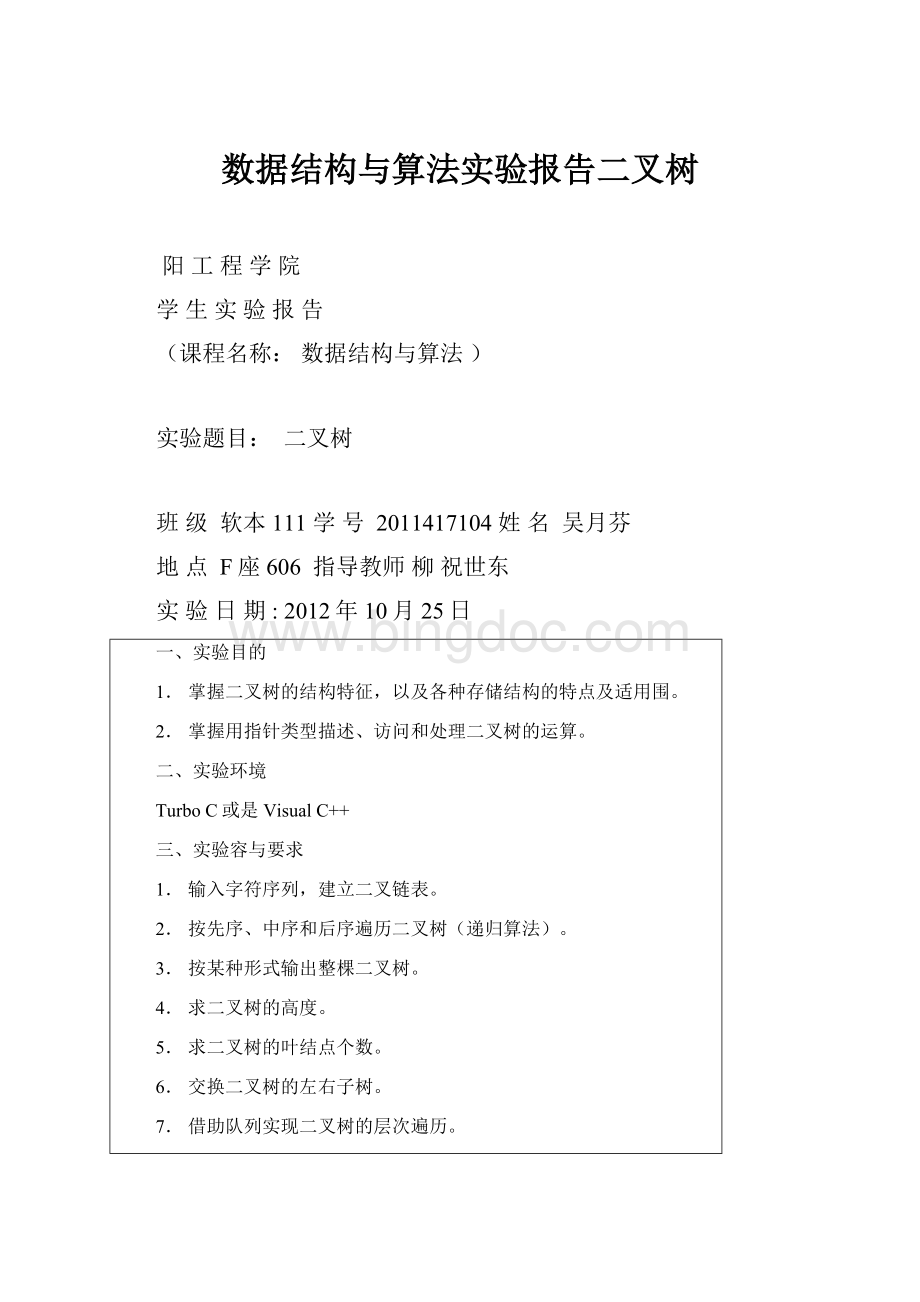数据结构与算法实验报告二叉树.docx
《数据结构与算法实验报告二叉树.docx》由会员分享,可在线阅读,更多相关《数据结构与算法实验报告二叉树.docx(13页珍藏版)》请在冰点文库上搜索。

数据结构与算法实验报告二叉树
阳工程学院
学生实验报告
(课程名称:
数据结构与算法)
实验题目:
二叉树
班级软本111学号2011417104姓名吴月芬
地点F座606指导教师柳祝世东
实验日期:
2012年10月25日
一、实验目的
1.掌握二叉树的结构特征,以及各种存储结构的特点及适用围。
2.掌握用指针类型描述、访问和处理二叉树的运算。
二、实验环境
TurboC或是VisualC++
三、实验容与要求
1.输入字符序列,建立二叉链表。
2.按先序、中序和后序遍历二叉树(递归算法)。
3.按某种形式输出整棵二叉树。
4.求二叉树的高度。
5.求二叉树的叶结点个数。
6.交换二叉树的左右子树。
7.借助队列实现二叉树的层次遍历。
8.在主函数中设计一个简单的菜单,调试上述算法,要求1-3必做,4-7为选做。
为了实现对二叉树的有关操作,首先要在计算机中建立所需的二叉树。
建立二叉树有各种不同的方法。
一种方法是利用二叉树的性质5来建立二叉树,输入数据时需要将结点的序号(按满二叉树编号)和数据同时给出:
(序号,数据元素)。
图4.1所示二叉树的输入数据顺序应该是:
(1,a),(2,b),(3,c),(4,d),(6,e),(7,f),(9,g),(13,h)。
另一种算法是主教材中介绍的方法,这是一个递归方法,与先序遍历有点相似。
数据的组织是先序的顺序,但是另有特点,当某结点的某孩子为空时以字符“#”来充当,也要输入。
这时,图4.1所示二叉树的输入数据顺序应该是:
abd#g###ce#h##f##。
若当前数据不为“#”,则申请一个结点存入当前数据。
递归调用建立函数,建立当前结点的左右子树。
四、实验过程及结果分析
(一)二叉树
1.二叉树的综合程序源代码如下所示:
#include
#include
#defineNULL0
structbitree
{
chardata;
structbitree*lchild,*rchild;
};
structbitree*createbitree_1(structbitree*t)
{
intch;
scanf("%d",&ch);
if(ch==0)
{
t=NULL;
}
else
{
t->data=ch;
t->lchild=(structbitree*)malloc(sizeof(structbitree));
t->lchild=createbitree_1(t->lchild);
t->rchild=(structbitree*)malloc(sizeof(structbitree));
t->rchild=createbitree_1(t->rchild);
}
returnt;
}
structbitree*createbitree_2(structbitree*t)
{
intch;
scanf("%d",&ch);
if(ch==0)
{
t=NULL;
}
else
{
t->lchild=(structbitree*)malloc(sizeof(structbitree));
t->lchild=createbitree_2(t->lchild);
t->data=ch;
t->rchild=(structbitree*)malloc(sizeof(structbitree));
t->rchild=createbitree_2(t->rchild);
}
returnt;
}
voidpreorder_1(structbitree*T)
{
if(T!
=NULL)
{
printf("%d\t\t",T->data);
preorder_1(T->lchild);
preorder_1(T->rchild);
}
}
voidpreorder_yezi(structbitree*T)
{
if(T!
=NULL)
{
if(T->lchild==NULL&&T->rchild==NULL)//只输出叶子节点
printf("%d\t\t",T->data);
preorder_1(T->lchild);
preorder_1(T->rchild);
}
}
voidinorder_1(structbitree*H)
{
if(H)
{
inorder_1(H->lchild);
printf("%d\t\t",H->data);
inorder_1(H->rchild);
}
}
voidpreorder_2(structbitree*p)
{
structbitree*s[100];
inttop=-1;
while(p!
=NULL||top!
=-1)
{
while(p!
=NULL)
{
top++;
s[top]=p;
printf("%d\t\t",p->data);
p=p->lchild;
}
if(top!
=-1)
{
p=s[top];
top--;
p=p->rchild;
}
}
}
voidpreorder_yezi_2(structbitree*p)
{
structbitree*s[100];
inttop=-1;
while(p!
=NULL||top!
=-1)
{
while(p!
=NULL)
{
top++;
s[top]=p;
if(p->lchild==NULL&&p->rchild==NULL)//只输出叶子节点
printf("%d\t\t",p->data);
p=p->lchild;
}
if(top!
=-1)
{
p=s[top];
top--;
p=p->rchild;
}
}
}
voidinorder_2(structbitree*p)
{
structbitree*s[100];
inttop=-1;
while(p!
=NULL||top!
=-1)
{
while(p!
=NULL)
{
top++;
s[top]=p;
p=p->lchild;
}
if(top!
=-1)
{
p=s[top];
top--;
printf("%d\t\t",p->data);
p=p->rchild;
}
}
}
voidmenu_1()
{
printf("\n\t******菜单*******\n");
printf("\t1.树的建立\n");
printf("\t2.树的遍历\n");
printf("\t0.退出\n");
}
voidmenu_2(intn)
{
if(n==1)
{
printf("\n\t******菜单*******\n");
printf("\n\t1.树的递归的先序建立\n");
printf("\n\t2.树的递归的中序建立\n");
printf("\n\t3.树的非递归的先序建立\n");
printf("\n\t4.树的非递归的中序建立\n");
}
if(n==2)
{
printf("\n\t******菜单*******\n");
printf("\n\t1.树的递归的先序遍历\n");
printf("\n\t2.树的递归的中序遍历\n");
printf("\n\t3.树的非递归的先序遍历\n");
printf("\n\t4.树的非递归的中序遍历\n");
printf("\n\t5.树的递归的先序遍历叶子节点\n");
printf("\n\t6.树的非递归的先序遍历叶子节点\n");
}
}
voidmain()
{
structbitree*H;
intn,m;
H=(structbitree*)malloc(sizeof(structbitree));
do
{
menu_1();
scanf("%d",&n);
if(n>2||n<0)
printf("\n\t\t您的输入有误!
");
elseif(n!
=0)
{menu_2(n);scanf("%d",&m);}
if(n==1)
{
if(m==1)
H=createbitree_1(H);
if(m==2)
H=createbitree_2(H);
}
if(n==2)
{
if(m==1)
preorder_1(H);
if(m==2)
inorder_1(H);
if(m==3)
preorder_2(H);
if(m==4)
inorder_2(H);
if(m==5)
preorder_yezi(H);
if(m==6)
preorder_yezi_2(H);
}
}while(n!
=0);
}
2.运行过程
二叉树递归的先序建立过程如图1.1所示。
图1.1先序建立二叉树
二叉树的递归的先序遍历如图1.2所示。
图1.2递归先序遍历
二叉树的递归的中序遍历如图1.3所示。
图1.3递归的中序遍历
二叉树的非递归的先序遍历如图1.4所示。
图1.4非递归的先序遍历
二叉树的非递归的中序遍历如图1.5所示。
图1.5非递归的中序遍历
二叉树的递归的先序遍历叶子节点如图1.6所示。
图1.6递归的先序遍历叶子节点
二叉树的非递归的先序遍历叶子节点如图1.7所示。
图1.7非递归的先序遍历叶子节点
结束程序操作如图1.8所示。
图1.8结束程序
五、成绩评定
优
良
中
及格
不及格
出勤
容
格式
创新
效果
总评
指导教师:
年月日